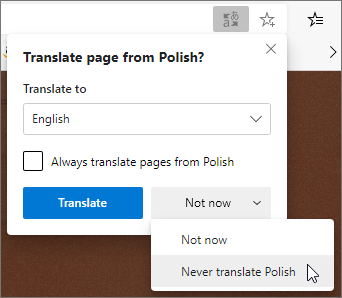If you open a page written in a different language than your preferred languages in settings, Microsoft Edge will automatically prompt you to translate it.
The Translate icon
Translate a webpage in Microsoft Edge
-
Open a webpage in Microsoft Edge. The browser will detect the language of the page, and a menu will appear asking you to confirm that you want to translate the page.
-
Do any of the following:
-
In the Translate to dropdown, choose the language you want the page translated into. The default is the language you've set for Microsoft Edge.
-
To translate the page, click Translate.
-
To always automatically translate from the source language, select the Always translate from [Language] check box.
-
To skip translation, in the list on the lower right, select Not now to skip translation or Never translate [Language] to never have the panel appear when you go to a page using that language.
Note: You can manually return to this panel later, even if you select the option to Never translate.
-
-
Inside the address bar, you'll briefly see the status showing that the page has been translated.
Manually translate webpage
If you've set Microsoft Edge to never translate a specific language, you won't see an automatic pop-up prompting you to translate. However, you'll still be able to translate it manually at any time.
To translate the page into a different language:
-
Select the translate icon
-
In the Translate to menu, select which language you want to translate to.
-
Select Translate.
Revert translated webpage back to original language
-
On the address bar, select the translate icon
-
Select Show original.
Turn translation in Microsoft Edge on or off
By default, Microsoft Edge will automatically prompt page translations.
To modify this setting:
-
At the top corner of the browser, select Settings and more
-
Select Languages.
-
Enable or turn off Offer to translate pages that aren't in a language I read.
By default, Microsoft Edge uses the same language as your system. For more information about using different languages in Microsoft Edge, learn how to use Microsoft Edge in another language.


















